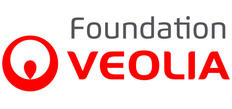Volunteers are employees who are prepared to travel to the four corners of the world to put their experience and skills at the service of others.
A Veoliaforce volunteer is a Veolia employee who, during his or her working hours, goes on a mission on behalf of the Veolia Foundation. Previously trained in humanitarian emergencies and the use of intervention equipment designed by the Foundation, they may be in the field for several weeks or provide their expertise remotely. They leave at the request of international humanitarian organisations after a disaster or to improve the living conditions of the most disadvantaged on a long-term basis. They provide expertise in one of the Group's core businesses: Water, Energy, Waste;
The Foundation coordinates and pays for logistics and travel expenses; Veoliaforce volunteers continue to be paid as if they were working in their usual job.
What about ERUs? Veoliaforce volunteers can be made available to the French Red Cross, a long-standing partner of the Veolia Foundation, to join its Emergency Response Teams (ERU). Illustration after the September 2023 earthquake in Morocco.
Become a Veoliaforce volunteer?
Employees of the Veolia Group can apply to be included among the Veoliaforce volunteers of the Veolia Foundation by following this link (access reserved for Group employees):
For which missions?
Since its creation in 2004, the Veolia Foundation has carried out nearly 250 expert missions, both on development projects and in humanitarian emergencies. Illustrations in Pakistan, Haiti, Lebanon, Bangladesh, Myanmar...
Veoliaforce volunteers's stories

Paul Sagot: "We're going to hear about Saniforce!"

Technical Studies and Projects Engineer, Paul Sagot, has hastily left for Uganda for a mission of a few weeks. The goal: to deploy Saniforce, the fecal sludge treatment solution designed by the Veolia Foundation for humanitarian aid, in a refugee camp.

Jérôme Lopez: « In Mayotte, resilience means survival. »

He has already carried out missions in Saint-Martin after Hurricane Irma, and in Lebanon after the explosion in Beirut, but his 15 days in Mayotte will have been unprecedented for Jérôme Lopez. Here are some explanations, on his return from his assignment as a Veoliaforce volunteer for the French Red Cross.

Quitterie de La Villegeorges: “Being in the right place to initiate change, support it and multiply its impact.”

What is CSR / CSR? For whom and why? These and many other questions were put to Quitterie de La Villegeorges. A Veoliaforce volunteer with the Veolia Foundation, she was assigned to train students on these topics for 4 days. Here's her experience.

Charles Bourdin: “Aquaforces units are extraordinary!”

Stéphanie Doualan: “Making dirty water drinkable is pretty magical!”

Stéphanie Doualan, a laboratory technician with Veolia Franciliane, spent two weeks in Mayotte as a Veoliaforce volunteer. In particular, she operated the Veolia Foundation's mobile water purification stations alongside the French Red Cross. A mission like no other for this seasoned volunteer.

Julie Schmitt: “Training means lighting a flame that will itself be passed on.”

Water Quality Manager at Veolia Franciliane, Julie Schmitt left to train Médecins Sans Frontières staff in Pakistan. Why did she do this? She is a Veoliaforce volunteer from the Veolia Foundation, in parallel with her position at the Méry-sur-Oise plant. Here's how.

Valérie Gauthier : « It's not essential and yet being there, doing a little more, opens up so many perspectives. »

Valérie Gauthier, Division Manager at Veolia RVD Ile-de-France, led a mission with Médecins Sans Frontières in the Democratic Republic of Congo (DRC) and Rwanda on waste management. This is a major issue for an NGO whose environmental footprint is one of the key requirements for the coming years.

Nathalie Peraro: “Sharing a glass of water can be magical!”

Methods and performance engineer at Veolia, based in the PACA region, Nathalie Peraro spent two weeks on a mission in the Democratic Republic of Congo (DRC), assigned by the Foundation to support Médecins Sans Frontières (MSF) in the field.

Jocelyn Fillion-Nicollet: “A sea of white plastic.”

Jocelyn Fillion-Nicollet, delegated works coordinator at Veolia Eau Ile-de-France, was trained as a Veoliaforce volunteer in June 2023. Just over a year later, he left on a mission to the Democratic Republic of Congo (DRC) to train Médecins Sans Frontières (MSF) personnel in the deployment of Aquaforces 2000.

David Maisonneuve: “Tailor-made for each camp, with one criterion: impact.”

David Maisonneuve, Distribution Networks Manager for the Veolia Group, inaugurated the Veolia Foundation's mobilization in Eastern Chad, alongside the High Commissioner for Refugees, to improve access to drinking water in UN-run camps. He spent two weeks in the Ouaddaï region, near Farchana, where a dozen camps house several hundred thousand people.

Sylvain Mousset: “The best demonstration of our usefulness.”

Thomas Schwarz: “Expectations are high, and that's normal.”
It was back-to-school for some, back from mission for others. Thomas Schwarz, a Veoliaforce volunteer from Veolia Eau Ile-de-France (VEDIF), returned in early September after two weeks in Bangladesh. Assigned by the Veolia Foundation to the United Nations' International Office for Migration (IOM), he worked on optimizing Saniforce, the Veolia Foundation's fecal sludge post-treatment solution for the humanitarian sector.




